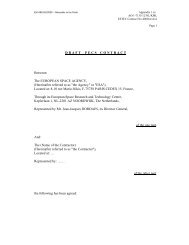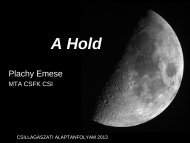Star Forming Regions in Cepheus
Star Forming Regions in Cepheus
Star Forming Regions in Cepheus
Create successful ePaper yourself
Turn your PDF publications into a flip-book with our unique Google optimized e-Paper software.
44<br />
molecular core associated with FIRS 2, and Fuente et al. (2005b) carried out a molecular<br />
survey of FIRS 2 and LkHα 234 with the aim of study<strong>in</strong>g the chemical evolution of<br />
the envelopes of <strong>in</strong>termediate-mass young stellar objects. Fuente (2008) present high<br />
angular resolution imag<strong>in</strong>g of the hot core of NGC 7129 FIRS 2, us<strong>in</strong>g the Plateau de<br />
Bure Interferometer. This is the first chemical study of an <strong>in</strong>termediate-mass hot core<br />
and provides important h<strong>in</strong>ts to understand the dependence of the hot core chemistry<br />
on the stellar lum<strong>in</strong>osity.<br />
Two molecular outflows were found <strong>in</strong> NGC 7129 by Edwards & Snell (1983).<br />
They seem to be associated with LkHα 234 and FIRS 2. We<strong>in</strong>traub et al. (1994), via<br />
near <strong>in</strong>frared polarimetry, identified a deeply embedded source, NGC 7129 PS 1, located<br />
about 3 ′′ northwest of LkHα 234. This source was not identified <strong>in</strong> the direct<br />
near-<strong>in</strong>frared images of LkHα 234, which revealed 5 sources (IRS 1–IRS 5, IRS 1 ≡<br />
LkHα 234) <strong>in</strong> a 20 ′′ × 20 ′′ field centered on LkHα 234. We<strong>in</strong>traub et al. (1996) detected<br />
NGC 7129 PS 1 at 3.8 µm, and proposed that it was the actual outflow source<br />
<strong>in</strong>stead of LkHα 234.<br />
Cabrit et al. (1997) present high-resolution imag<strong>in</strong>g of the region around LkHα 234<br />
<strong>in</strong> the 10 µm and 17 µm atmospheric w<strong>in</strong>dows and <strong>in</strong> the H 2 v=1-0 S(1) l<strong>in</strong>e and adjacent<br />
cont<strong>in</strong>uum. The cold mid-<strong>in</strong>frared companion, detected at 2.7 ′′ to the north-west<br />
of the optical star, corresponds to NGC 7129 PS 1. The companion illum<strong>in</strong>ates an arcshaped<br />
reflection nebula with very red colors, and is associated with a radio cont<strong>in</strong>uum<br />
source, H 2 O masers, and a bright extended H 2 emission knot, <strong>in</strong>dicat<strong>in</strong>g that it is deeply<br />
embedded and has strong outflow activity. Cabrit et al. (1997) refer to this star as IRS 6,<br />
extend<strong>in</strong>g We<strong>in</strong>traub et al.’s notation.<br />
Fuente et al. (2001) obta<strong>in</strong>ed s<strong>in</strong>gle-dish and <strong>in</strong>terferometric cont<strong>in</strong>uum images at<br />
2.6 mm and 1.3 mm of both FIRS 2 and LkHα 234. They identified two millimeter<br />
sources associated with FIRS 2: FIRS 2–MM1, apparently associated with the CO outflow,<br />
and a weaker source, FIRS 2–MM2, which does not present any sign of stellar activity.<br />
The <strong>in</strong>terferometric 1.3 mm cont<strong>in</strong>uum image of FIRS 1 reveals that LkHα234 is<br />
a member of a cluster of embedded objects. Two millimeter clumps are associated with<br />
this far-<strong>in</strong>frared source. The stronger is spatially co<strong>in</strong>cident with IRS 6. A new millimeter<br />
clump, FIRS 1–MM1, is detected at an offset (−3.23 ′′ , 3.0 ′′ ) from LkHα 234. The<br />
extremely young object FIRS 1–MM1 (it has not been detected <strong>in</strong> the near- and mid<strong>in</strong>frared)<br />
is the likely driv<strong>in</strong>g source of the H 2 jet. There is no evidence for the existence<br />
of a bipolar outflow associated with LkHα 234. In addition to FIRS 1 and FIRS 2, six<br />
other compact millimeter clumps are detected <strong>in</strong> the region, NGC 7129 MM1 to MM5<br />
(see Fig. 13), and the sixth co<strong>in</strong>cides with the bipolar nebula RNO 138.<br />
Submillimeter cont<strong>in</strong>uum observations by Font et al. (2001) revealed three compact<br />
sources: LkHα 234 SMM 1, LkHα 234 SMM 2 and FIRS 2. SMM 1 co<strong>in</strong>cides<br />
with IRS 6, which, accord<strong>in</strong>g to the submillimeter observations, may be a deeply embedded<br />
Herbig Be star, whereas SMM 2 is a newly discovered source (see Figure 14).<br />
Table 8 shows the coord<strong>in</strong>ates, wavelengths of detection, measured fluxes and sizes of<br />
the deeply embedded young stellar objects <strong>in</strong> NGC 7129, observed <strong>in</strong> submillimeter,<br />
millimeter, and centimeter cont<strong>in</strong>uum.<br />
Low-mass pre-ma<strong>in</strong> sequence members of NGC 7129 were identified as Hα emission<br />
objects by Hartigan & Lada (1985), Miranda et al. (1993), and Magakian et al. (2004),<br />
as variable stars (Semkov 2003) and near-<strong>in</strong>frared sources (Strom et al. 1976; Cohen<br />
& Schwartz 1983). Muzerolle et al. (2004) presented observations of NGC 7129 taken<br />
with the Multiband Imag<strong>in</strong>g Photometer for Spitzer (MIPS). A significant population


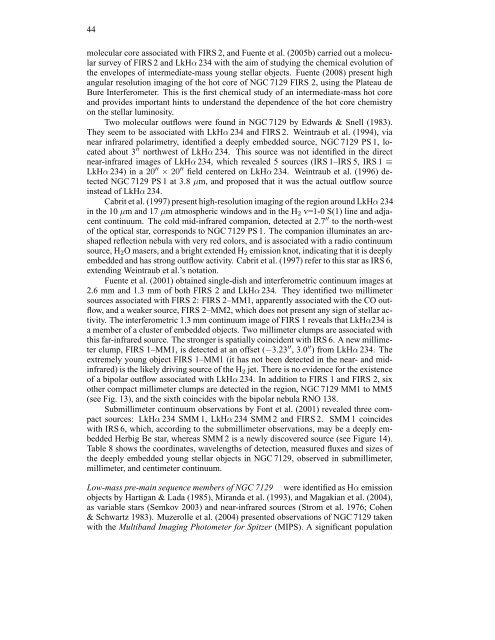


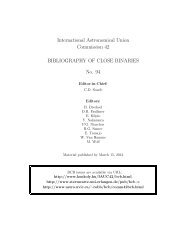

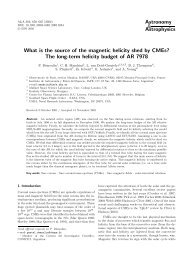


![[001] Kov5acs, G. and VetUo, B. 1979, 'Observations of Two Low ...](https://img.yumpu.com/23925638/1/190x245/001-kov5acs-g-and-vetuo-b-1979-observations-of-two-low-.jpg?quality=85)
